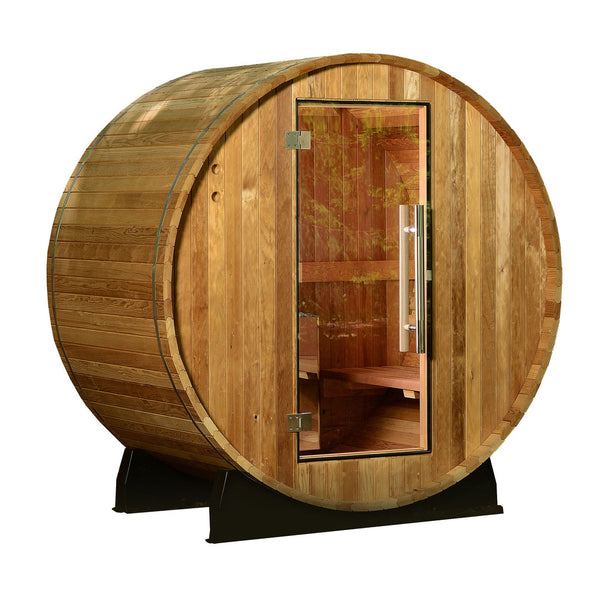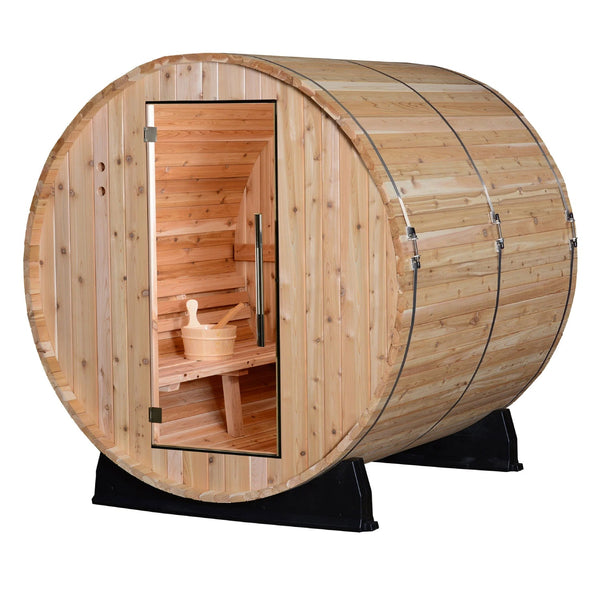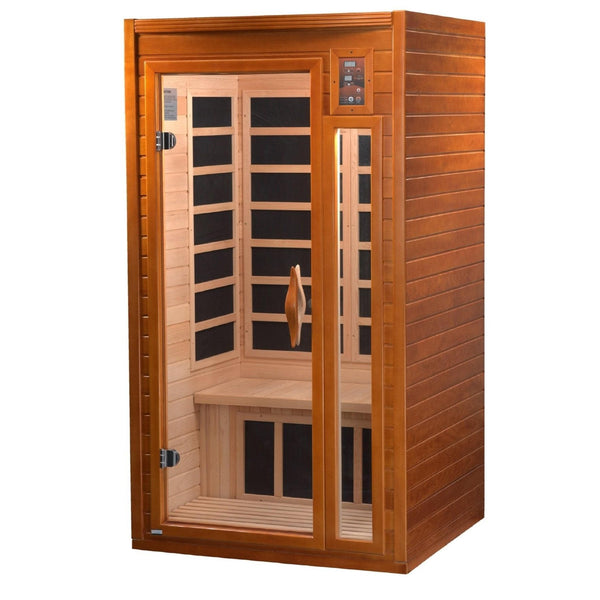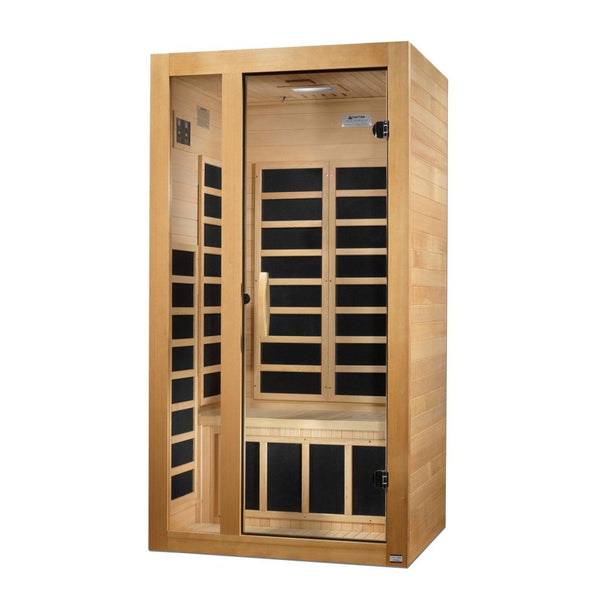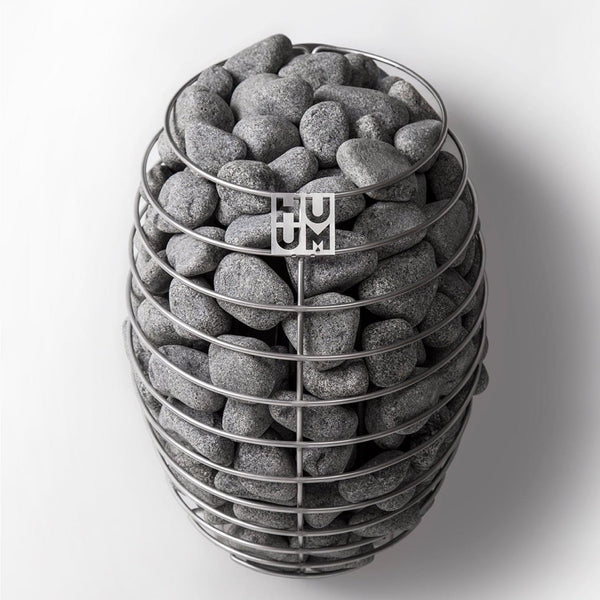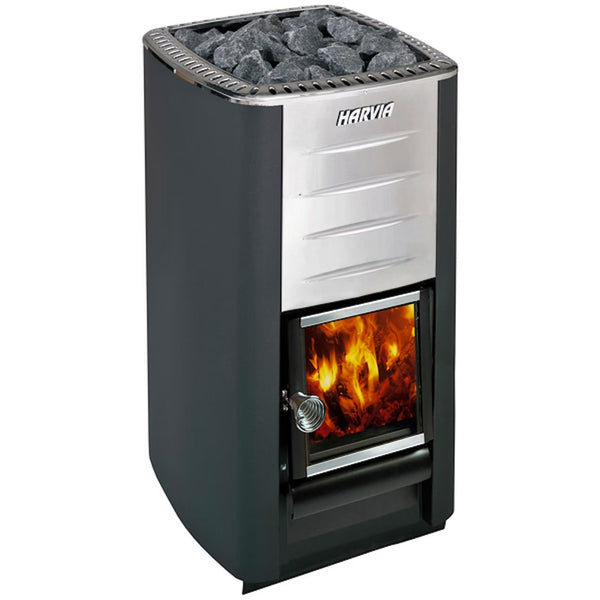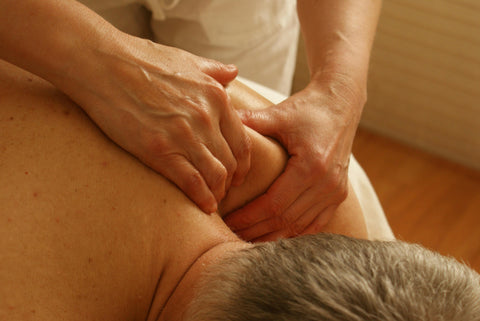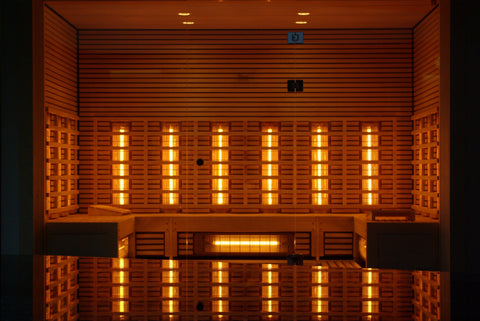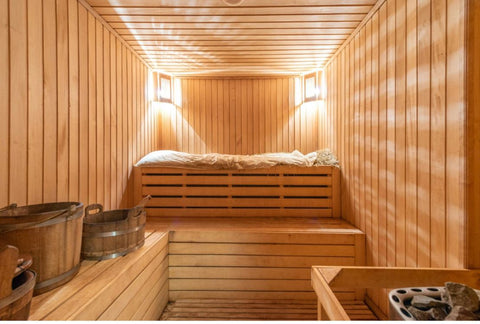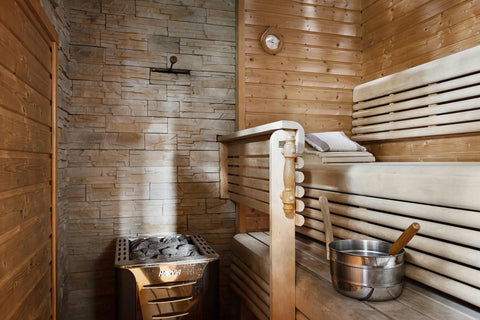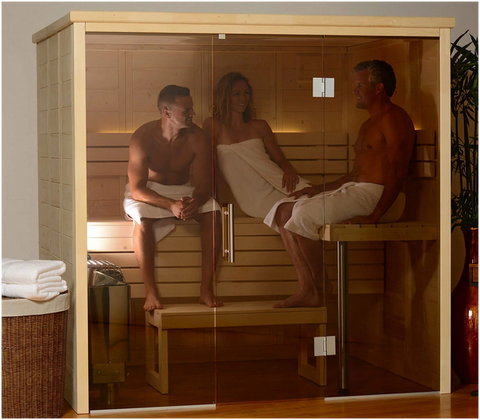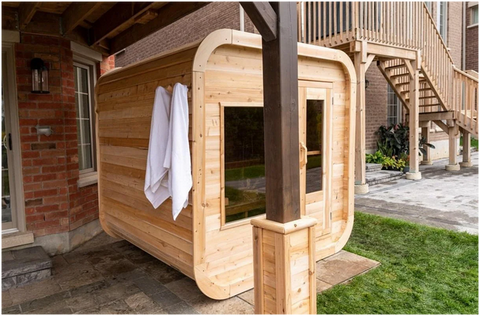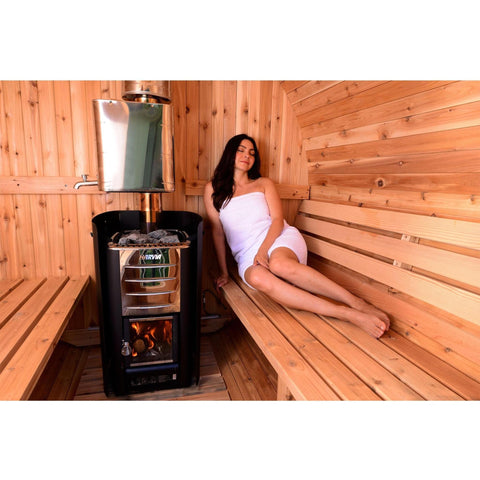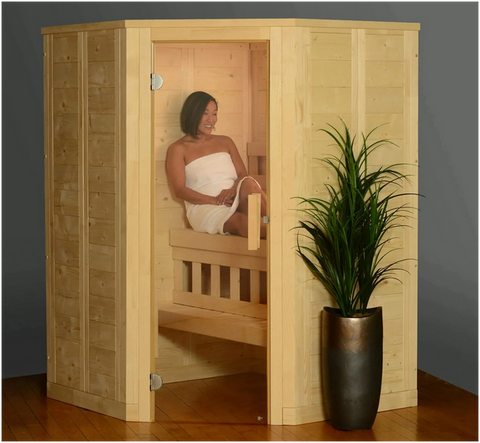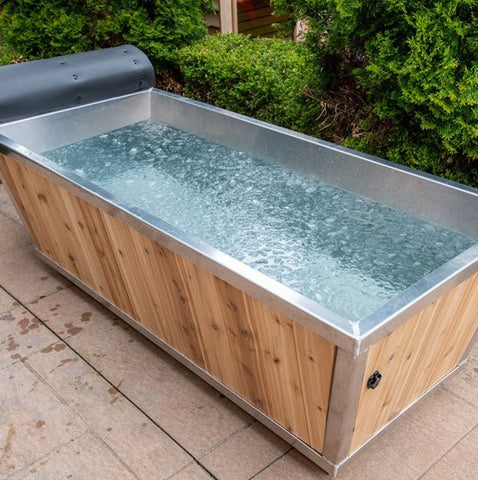
Stepping into a sauna is like entering a sanctuary of warmth and relaxation, where the day's stress melts away.
Whether you're a seasoned enthusiast or a newcomer, understanding sauna etiquette is important for maximizing your experience and ensuring the comfort of others.
Saunas are communal spaces designed for tranquility and rejuvenation, and respecting a few simple guidelines on sauna etiquette can help maintain their serene atmosphere.
From pre-session preparations to post-sauna protocols, our sauna etiquette guide covers everything you need for an enjoyable and relaxing visit.
Our Top 3 Backyard Home Saunas
Want to find an outdoor sauna for sale that allows you dictate your own rules on sauna etiquette? Explore our top 3 recommended saunas, each chosen for outstanding features and benefits. These saunas ensure a premium experience tailored to your needs, combining superior design and ultimate comfort.
|
Almost Heaven Seneca 4-6 Person Classic Barrel Sauna |
Canadian Timber Georgian Cabin 2-6 Person Sauna |
Haljas Hele Glass Single Standard 4-Person Outdoor Sauna House |
 |
 |
 |
|
- 1-3/8″ thick ball-and-socket lumber - LED lighting inside - Heater guard made of western cedar - Stainless steel bands, hinges, and fasteners - Polymer support cradles designed to withstand weather conditions |
- 48" (120cm) changeroom with front windows and side wall benches - 28-gauge black matte steel roof panels, made in Canada - Large front windows with 5mm bronze tempered glass on the front and middle walls - 2-tier back wall benches and single-tier L benches on either side |
- Accommodates up to 4 individuals - Interior made of Thermo Alder wood - Standard Alder wood ceiling - Suitable for use with a 12kW wood-fired sauna heater - Built and designed in Estonia |
Preparing for Your Sauna Session
While you mull over the possibilities of your own personal sauna, let’s learn about sauna etiquette for when you’re at the gym’s sauna or other public saunas. Take the following steps to prepare for a relaxing and enjoyable shared space experience. Follow these sauna etiquette guidelines to make the most out of your sauna sessions.
Freshen Up with a Pre-Sauna Shower
A quick shower is essential before entering public saunas. This simple step removes sweat and body oils, helping to maintain the sauna's pristine environment and enhancing your overall experience. A fresh start ensures everyone enjoys the pure, steamy atmosphere.
What to Wear
While public saunas offer towels, you might want to bring your own towel. For your comfort and hygiene, bring two towels: one to sit on and another to dry yourself with after your session.
Wearing a bathing suit is also an option if you prefer more coverage or wear clothes made of lightweight, natural fibers that handle heat well.
The key to proper attire in sauna etiquette is to feel comfortable and respect sauna customs.
Stay Hydrated
Hydration is vital for a safe and enjoyable sauna. Drink water before, during, and after your session to replenish the fluids lost through sweating.
Keep water bottles handy to stay refreshed and balanced throughout your visit.
Entering the Sauna
Stepping into the sauna quietly is essential for maintaining its peaceful atmosphere. Choose a spot thoughtfully, ensuring you sit comfortably without crowding others or disrupting the airflow.
In busier saunas, be considerate by choosing an area where you can relax without encroaching on others' personal space.
Choose a lower bench for a cooler temperature to ease into the sauna's heat. This gradual method allows your body to acclimate comfortably.
If the heat becomes intense or you're new to saunas, consider taking short breaks outside to cool down before returning. This careful acclimatization enhances your comfort and helps maintain a serene environment for all sauna users.
By entering considerately and adjusting to the heat at your own pace, you contribute to a harmonious and enjoyable experience for all.
Behavior Inside the Sauna
Maintaining a respectful and serene atmosphere in the sauna is essential for everyone’s enjoyment.
Keep conversations to a minimum and speak softly, preserving the peaceful environment integral to the sauna.
Being mindful of others means maintaining silence and respecting personal space. On crowded benches, keep enough space between yourself and others to stay comfortable.
For sauna beginners, start on the lower benches with cooler temperatures. This gradual approach helps your body adjust comfortably. Once you’re comfortable, try moving to the higher, hotter benches.
Always listen to your body and go at your own pace. Typically, a sauna session should last about 10 to 20 minutes, but it's vital to exit the sauna if you start feeling dizzy or uncomfortable.
Regular breaks for cooling down and hydration are key to a safe and pleasant experience.
Sauna Dos and Don’ts

For the best sauna experience, follow these key practices and avoid common mistakes. This guide to sauna culture will help you enjoy your session and show respect for the space and those around you.
Essential Practices
- Maintain Cleanliness: Sitting on a towel and cleaning up after yourself makes the sauna hygienic and pleasant. After your session, remove your towel and any personal items to leave the sauna tidy.
- Respect the dress code: Whether at a gym sauna or a traditional sauna, follow the specific rules for attire in each place.
- Stay Hydrated and Manage Heat Exposure: Regular hydration and cooling breaks are crucial for safety and comfort. Don’t sit too close to the wood-burning stove or heater.
- Monitor Your Time: Overexposure to high heat can be unsafe, leading to dehydration or heat-related illnesses. Listen to your body and exit the sauna if you start to feel uncomfortable or unwell.
- Respect Heat Preferences: Different users have varying preferences for sauna humidity and heat levels. It’s generally a good idea to ask permission before increasing the heat or pouring water on the sauna stones.
What to Avoid
- Bringing Electronics: This one is a big no-no. Leave phones and other electronics in the locker room outside the sauna to avoid damage and maintain a tranquil environment.
- Wearing Heavy or Tight Clothing: Opt for lightweight, breathable fabrics, such as a towel or loose swimwear, that allow your skin to breathe and sweat freely.
- Overstaying to ‘Win’: Exit the sauna if you start feeling dizzy or unwell. The sauna is not a competition of who can stay the longest.
Adhering to these sauna guidelines will elevate your comfort while being considerate of others. From seasoned sauna enthusiasts to first-timers, everyone benefits from these practices, fostering a serene and rejuvenating ambiance.
|
Sauna Yoga: Combine the benefits of yoga with the sauna’s heat by practicing gentle yoga poses inside the sauna. (But do keep in mind that this isn’t etiquette in most public saunas.) |
Essential Post-Sauna Practices
Properly finishing your sauna is just as important as how you start it. The post-sauna routine helps your body recover from the heat and enhances the overall benefits of your sauna experience.
Here’s how to wrap up your time in the sauna effectively:
Cool Down Gradually
After exiting the sauna, let your body cool down gradually. According to a study on human physiological responses to immersion into water of different temperatures, rapid cooling after a sauna, such as immersion in cold water, can induce significant physiological responses.
These responses include a sharp increase in heart and metabolic rates and a significant drop in core temperature, all of which can contribute to body shock.
Start by sitting in a cooler environment for a few minutes to let your body adjust. You can also take a lukewarm or cool shower to rinse off sweat and refresh yourself, but avoid cold water immediately after your session.
This gradual cooling helps stabilize your body temperature and prevents sudden stress on your cardiovascular system.
Rehydrate and Replenish
Replenishing fluids is essential after a sauna. Sweating in the sauna can lead to significant fluid loss, so rehydration is important.
If you’ve had a particularly intense session, you might also consider drinks with electrolytes. Eating a light snack with healthy carbs or proteins can help restore energy levels and support recovery.
Rest and Relax
After your sauna, give yourself some time to rest. Find a comfortable place to relax and let your body continue to cool down naturally.
This period of rest allows your heart rate and blood pressure to normalize. To extend the benefits of your sauna experience, practice mindfulness or deep breathing.
Moisturize Your Skin
The heat from the sauna can dry out your skin. After cooling down and rehydrating, apply a good-quality moisturizer to help replenish your skin’s moisture barrier.
This helps keep your skin hydrated and smooth, enhancing the detoxifying and rejuvenating effects of the sauna.
Reflect on Your Experience
Taking a few minutes to reflect on your sauna session can significantly enhance your overall experience.
After each session, consider how your body and mind felt during and after the sauna. Were there moments of intense heat or discomfort? What was your mood like before entering and after leaving the sauna?
These insights can guide you in customizing your sauna routine to suit your preferences and wellness goals.
|
Mindful Breathing Techniques: To enhance relaxation in the sauna, practice deep, controlled breathing. Focus on inhaling slowly through your nose and exhaling gently through your mouth. |
Special Considerations

When using a sauna, it's important to consider various factors that can impact your experience. By keeping these in mind, you can tailor your session to meet your specific needs, ensuring it is safe and enjoyable for everyone.
Health Conditions
If you have any pre-existing health conditions, it’s important to consult with a healthcare provider before using a sauna.
Conditions such as heart disease, high or low blood pressure, respiratory issues, or pregnancy can affect your ability to enjoy a sauna safely.
For instance, sauna heat can increase heart rate and blood pressure, making longer sessions risky for individuals with cardiovascular concerns.
Your doctor can provide personalized advice on whether sauna use is appropriate for you and what precautions to take to stay safe.
Cultural Sensitivities
Sauna traditions differ greatly across cultures, and respecting these differences is essential, especially when using a sauna abroad.
For instance, in Finland, saunas are deeply ingrained in the culture. They are often enjoyed without clothing and in mixed company, with a focus on silence and tranquility.
Conversely, other countries may have varying customs concerning attire, gender separation, or sauna rituals.
It's important to take a moment to understand and respect local sauna etiquette. Doing so ensures you adhere to cultural norms and contribute to a respectful environment.
Age Considerations
Sauna use can benefit people of all ages, but the experience should be tailored to each age group. Children and the elderly may be more sensitive to heat and should be monitored closely.
For children, shorter sessions at lower temperatures are recommended. Older adults should also be cautious, especially if they have health conditions that could be exacerbated by heat exposure.
Ensuring proper hydration and taking more frequent breaks can make the sauna experience safer and more enjoyable for these age groups.
Sensitivity to Heat
Individuals have different tolerances to heat, and what might be comfortable for one person could overwhelm another. It’s important to listen to your body and not push yourself beyond your comfort level.
If you’re particularly sensitive to heat, consider starting with lower temperatures and shorter sessions, gradually increasing as you become more accustomed to the environment.
This approach helps prevent discomfort and ensures a more pleasant experience.
Sauna Types and Their Effects
Different types of saunas, such as traditional wood-burning saunas, electric saunas, and infrared saunas, offer varied heat experiences.
Traditional saunas produce high heat and humidity, while infrared saunas provide heat through infrared light, resulting in lower air temperatures but deeper tissue penetration.
Understanding the type of sauna can help you prepare appropriately and choose the right approach for your session.
Experience Sauna Excellence
Mastering sauna etiquette enriches your personal experience and that of those around you. By entering quietly, respecting personal space, and being mindful of your body’s needs, you help maintain the serene and rejuvenating atmosphere that saunas are known for.
Always freshen up before entering, stay hydrated, and respect the tranquil environment.
At Select Saunas, we're passionate about enhancing your sauna journey. Explore our range of premium saunas and accessories designed to elevate your wellness routine.



